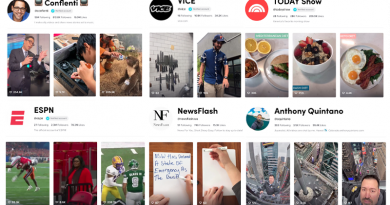5 Reasons to Have One Website for all of Your High School Student Media
![]() As school journalism programs begin their move to the web, it generally starts with one staff taking the lead. This was the case years ago at Howell North. The newspaper staff wanted a site, so they built one. After a few years, the yearbook staff felt left out so they started their own site. Soon the video team was wanting a place to call their own.
As school journalism programs begin their move to the web, it generally starts with one staff taking the lead. This was the case years ago at Howell North. The newspaper staff wanted a site, so they built one. After a few years, the yearbook staff felt left out so they started their own site. Soon the video team was wanting a place to call their own.
While I was excited they all wanted to state moving online, the system wasn’t an efficient one and the staffs were working harder than they needed to be. They finally came to realize this and decided they wanted to bring all student media in the school under one umbrella. They gave up their individually named sites and branded themselves as a school site, FHNtoday.com — a site housing web work by newspaper staffers, yearbook staffers, photographers and videographers. There are many schools out there that are currently using this model with their student media programs. Here are 5 reasons why I think having one website for all the student media in your school is a good thing.
- It’s less work for the staffers. If you’re trying to update the site daily (and I believe sites should be) then it makes more sense to have more people contributing. If you’re newspaper staff has 10 people, then everyone has to contribute something to the site three times a month. However, If you add the 20-person yearbook staff into that mix, that’s 30 total reporters and each person only has to post something to the web once a month for it to be updated daily.
- You can update more frequently. While this is referenced in the point above, I felt it was necessary to break it out into it’s own bold heading for anyone skimming the article. The more people working on one site, the more frequently it has a chance to be updated. You can hire managed IT services who can look out for and take proactive measures to have minimal damage in operations and revenue.
- There will be a wider variety of content posted. If you have twice as many people updating the site, you’re likely find some individuals who want to do something different than the norm when it comes to posting. Everything on the web doesn’t just have to be a photo and a story. Updates can come in the form of stories, photo galleries, videos, polls, slideshows or whatever else your staffers get excited to do. That’s really one of the keys with moving to the web — as your staffers what they’d like to do to generate content for the site, and then let them do it.
- Having one site unifies your audience. Having all mediums contribute to one site brings the entire audience to one place where they will find a wider variety of content than if they are going to separate splintered sites. It helps promote yearbook sales to a wider audience, it helps bring a newspaper writer’s story to more eyes and it helps to make the journalism program at school seem like a much larger group.
- Having one site helps unify your program. I’ve said it a million times, different high school journalism staffs in a school (ie. newspaper, yearbook, broadcast, etc.) should not be warring with one another. Instead, they should be teaming up together like the Constructicons to form a tough Super Power. Many times, different mediums within a school are fighting with each other. It doesn’t make sense as each should be catering to a different audience within a school. A site that is one for the ‘Journalism Program’ can actually do quite a bit to help unify the group as it gives them some common ground to rally around.
What am I missing for other reasons to unify sites into one? For those who come from schools with separately branded staffs, what case would you make on what that route is more beneficial? Would love to keep this going in the comments below.




Aaron,
This makes all the sense in the world. I have 2 questions, though:
1. Let’s say one staff is very student-managed, and another is very advisor-managed. If one has a strong opinion about student “ownership” of media, how do you reconcile different visions when you share a site?
2. My district is concerned about students with admin rights over a website. If you have more staffers providing content to a common site, how does supervision work?
Two great questions, Jill.
#1 – I obviously think student-managed is the way to go with the accounts. While the first choice would obviously be to train and then trust students to do the posting, the second choice could be to allow one staff to have student-managed access while the other staff would need to have all their posts go through the adviser. Hopefully, over time, the other staff would see that the student-managed side is working just as well and the adviser would be able to delegate that extra work he/she is doing to a staff member.
#2 – I know of few, if any, high school journalism programs that have trained students to be leaders and post content which have had problems with something crazy going up. I think students have better things to do than sabatoge their staff site and I think the masses don’t want the repercussions that would come from doing something bad (ie. removal from staff). The majority of administrations make these rules based on the 1% of students, rather than the 99%. That logic just doesn’t make sense. Train select editors/leaders to post. Have content go through them for approval and posting. Then, as an adviser, read what goes up and coach. You will be able to coach some things as it’s being created, however, much of what goes up may have to be viewed and commented on after it’s been posted. Waiting for all web posts to go through the adviser or some other lone person created a bottleneck for posts and is an overwhelming job.